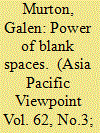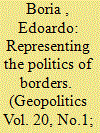|
|
|
Sort Order |
|
|
|
Items / Page
|
|
|
|
|
|
|
| Srl | Item |
| 1 |
ID:
182692


|
|
|
|
|
| Summary/Abstract |
A variety of maps depict a usefully approximate but inexact network of roads, rails, sea lanes and other infrastructures to represent something called China's Belt and Road Initiative (BRI). And yet, for a global programme that reflects and advances Beijing's new position as a leader of international development, BRI maps remain largely imprecise and unofficial. Taking this as a starting point of critical cartography, I ask why BRI development throughout the Tibet-Himalaya region remains conspicuously blank on most maps, and what work is accomplished by such cartographic silences. In contrast to this apparent invisibility, however, the BRI is very much present in Nepal – discursively, materially and cartographically. Chinese development programmes are widely anticipated, embraced and promoted as grand and spectacular things throughout Nepal. Following this friction of representation in the case of Chinese development in Nepal, I argue that the apparent paradox between the BRI as invisible thing and BRI as promised future reveals the manifold ways in which infrastructures articulate politics and, vice-versa, how politics articulate infrastructures.
|
|
|
|
|
|
|
|
|
|
|
|
|
|
|
|
| 2 |
ID:
138972


|
|
|
|
|
| Summary/Abstract |
The relationship between cartography and power has aroused much interest in recent years, stimulated by innovative critical approaches. The empiricist and neo-positivist paradigms, no longer satisfactory, have been abandoned, while the analysis has been extended to include not only state-sponsored, but also popular cartography. Regardless of the character of the map or its source, it continues to be inserted in the context of the modern territorial state, as it is perceived as a key instrument for conveying the state’s narrative. Seen in this light, cartography inevitably comes out on the subordinate end of this relationship, since it fully conforms to the orthodox state-centred world view that has dominated modernity. Overturning this mechanically deconstructionist approach, this paper proposes, instead, to apply a concept introduced by John Brian Harley, the father of critical cartography – that of the map’s internal power. This concept, usually considered a given and rarely tested in empirical studies, is evaluated here through an analysis of the border sign in a series of unorthodox maps (in the work of Reclus, Mackinder, Renner, Spykman, Horrabin, Radó, Ratzel, Kjèllen, Haushofer) which have received little scientific attention to date.
|
|
|
|
|
|
|
|
|
|
|
|
|
|
|
|
|
|
|
|
|